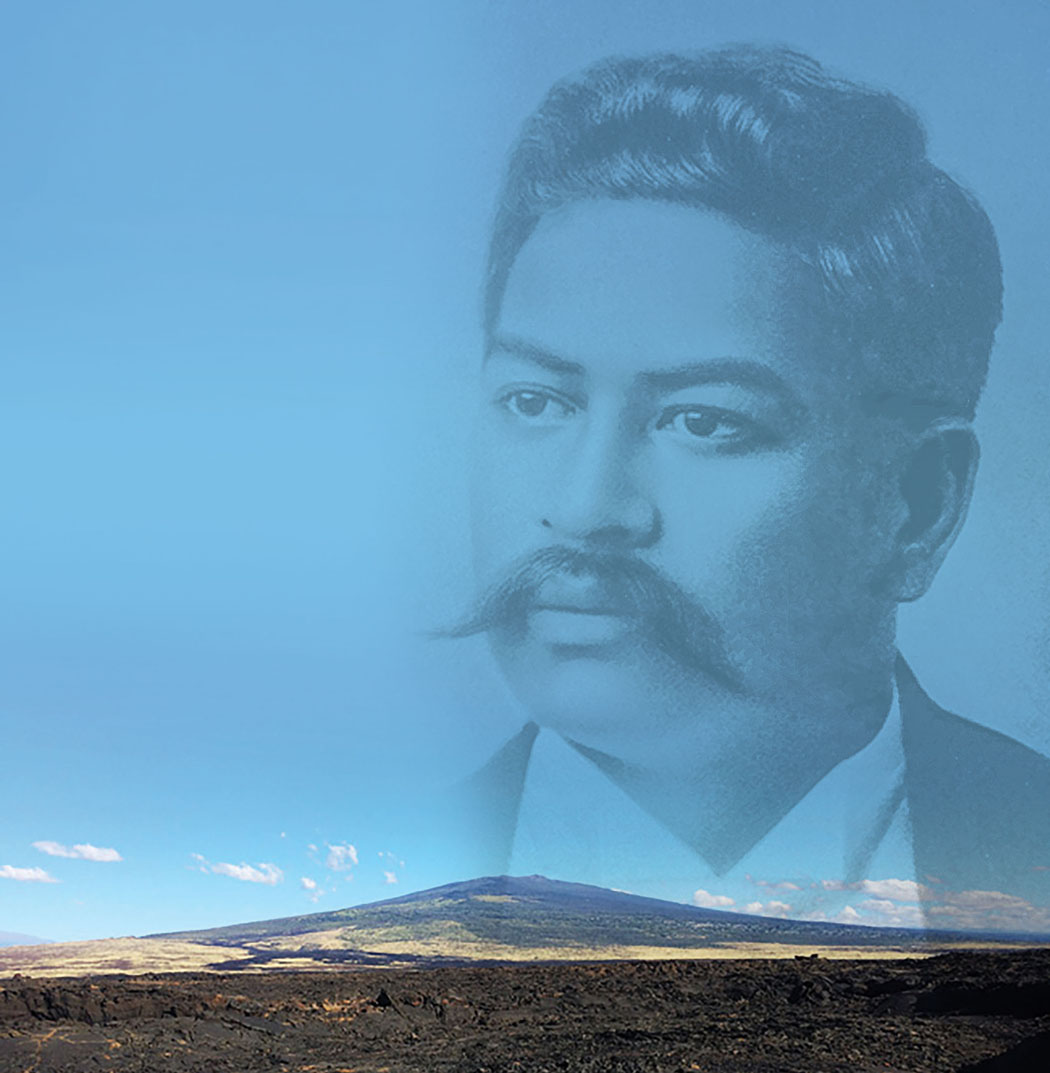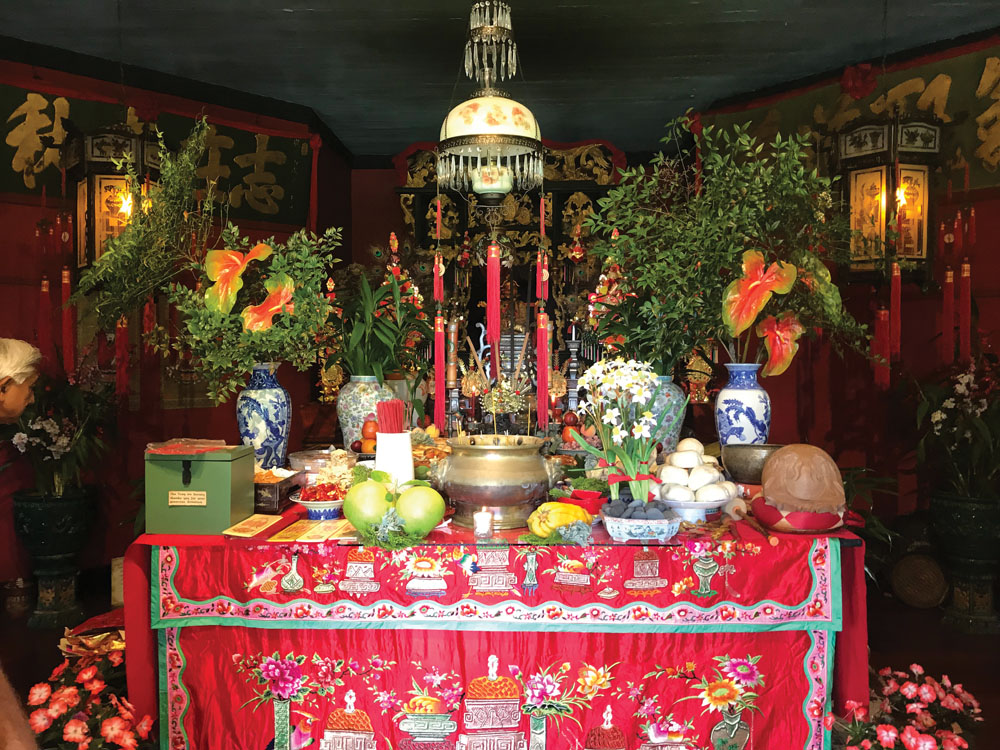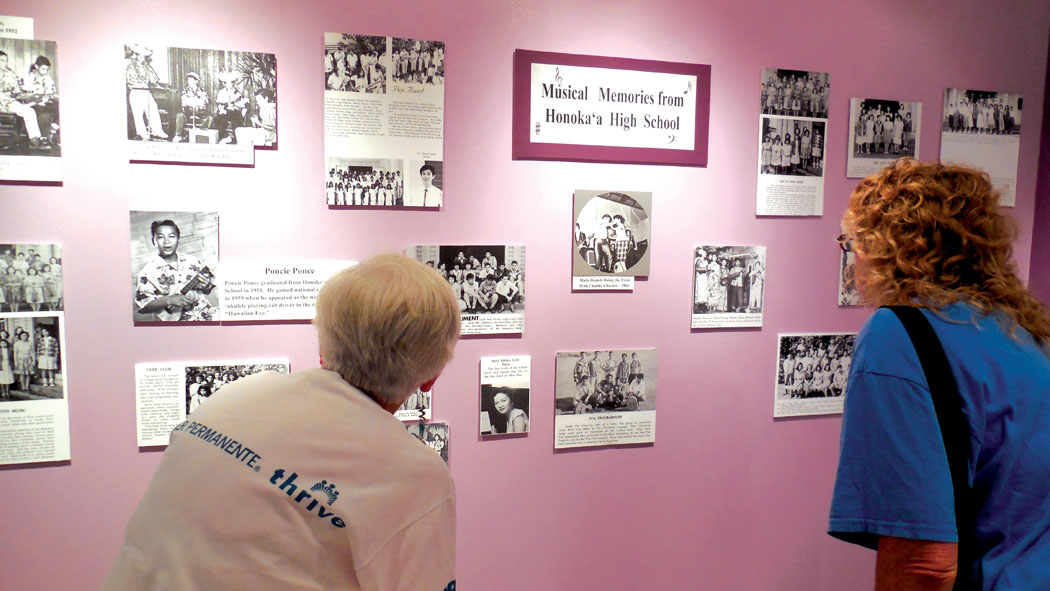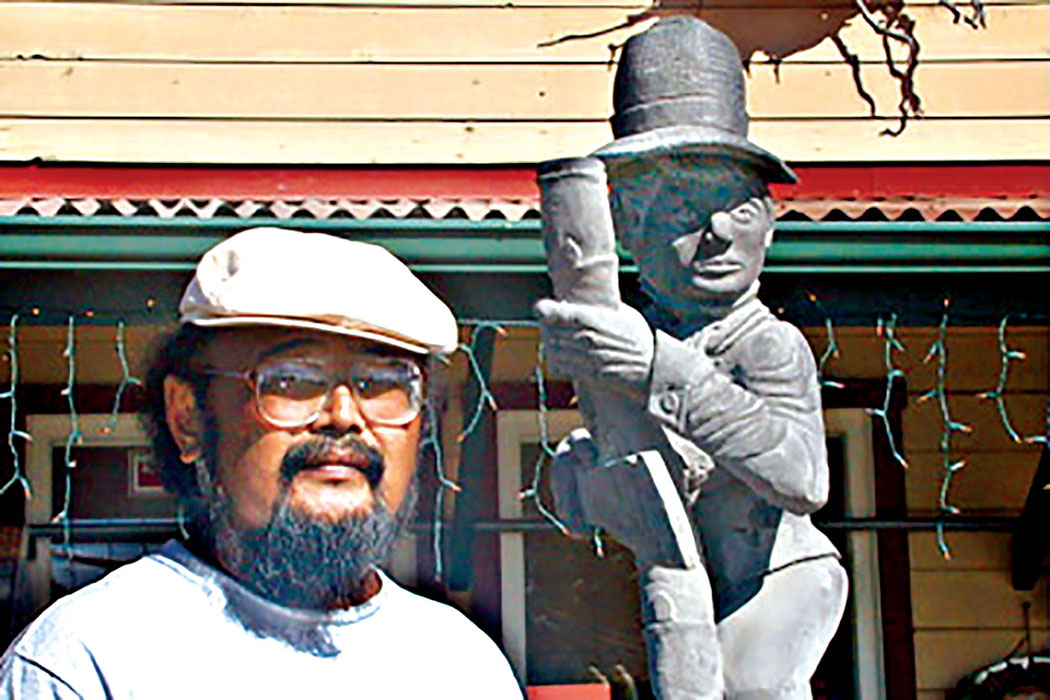
The Meditative Nature of Carving Stone
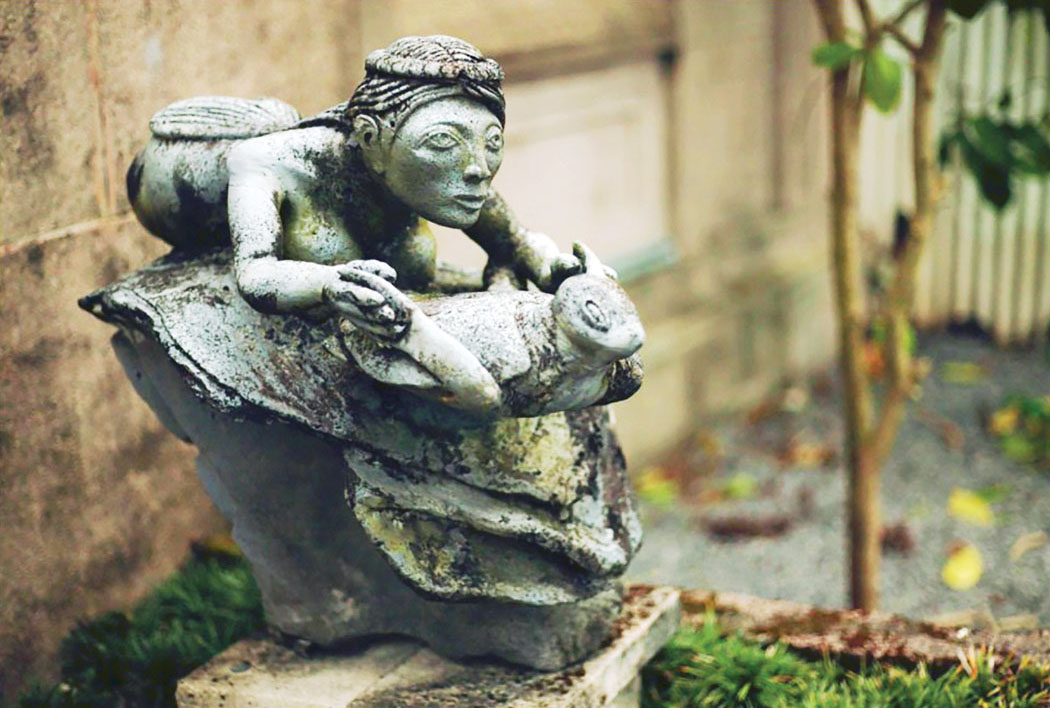
By Karen Valentine Kapono
For sculptor Fred Soriano, it’s a working partnership with the stone sculpture he is crafting that is both difficult and peaceful. Contemplating his creations, you get that impression yourself. Where did that stone come from and how long had it been in existence? What caused its shape and its imperfections, and what inspired the sculptor to choose it? Then, how much physical effort had to be expended while bringing to life the images in the sculptor’s brain?
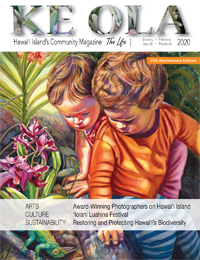
A retired professor of sociology at the University of Hawai‘i at Hilo, Fred devoted 10 years pre- and post-retirement to kālai ki‘i pōhaku, the carving of stone. “Working with stone gives me the largest resistance. You work with the stone and it resists because it’s hard. With resistance you reach at the plane of meditation; it’s very meditative. And then you reach a point where the endorphins kick in and you feel very relaxed and tranquil. It’s practicing the zen method of meditation. That’s what’s been my motivation for carving.”
Stones are believed to hold a certain life force as well as the memory of existence in their environments. The reverence for stones can be found in most ancient cultures and religions, for example the carved stones, stone arrangements, and constructions found in Greece, England, South America, Egypt, and Japan in particular.
According to traditional Hawaiian thought, pōhaku (stones) are living beings with mana (life force) and not inanimate objects. Kānaka ‘ōiwi (native people) also worshipped special stones as akua (gods). Some stones were carved and others were left in natural form.
In Japan, the emotional attachment to natural stones, originally religion-inspired, has persisted and is manifest today in the creation of richly symbolic and spiritual stone gardens.
Inspired by Japanese garden design, Fred began working with stones as installations in his own elaborate home garden. “The stones that I worked on were done in tandem with my landscaping and gardening,” he said. He has energetically applied chisel, mallet, grinder, and sander to sculpting the stone.

Bookbinder and author Charlene Asato was inspired to publish a book about Fred’s art, Kālai Ki‘i Pōhaku, Carver of Stone. In it she writes: “His early works were stone lanterns, some with a niche carved out to hold a candle, others a free balance of stones emerging from the ground. Most of these lanterns are sets of stones, not permanently joined in any way and so they stand, subject to the whims of nature.
“His stone pieces range from elements of a Japanese-style garden—lanterns, structures of balanced stone, fountains and miniature landscapes of mountains—to human figures of cultural significance.”
“I love looking at the stones over and over,” says Fred. “The stone chooses you. The stone gives you an idea of what it should be.”
He often quotes the words of poet William Wordsworth, who coined the phrase “intimations of immortality” in his “Ode: Intimations of Immortality from Recollections of Early Childhood,” as Fred contemplates the nature of the pohaku and immortality. “The whole summary of my experience in my intimations of immortality is: things are imperfect, incomplete, and impermanent.”

Charlene writes that Fred “celebrates nature, the elements and time. He has infused his work with the philosophy of Zen and wabi sabi, which sees beauty in the simple, the earthy and the inconspicuous elements of imperfection, incompletion, and decay in both nature and man-made things. Within these stones’ imperfections, Fred discovers their beauty within. Weatherworn flaws and imbedded elements bring the spirit of the stone to the surface and Fred captures this energy when he carves his sculptures.”
A child of the plantation with Filipino heritage, Fred has a lifetime of observing and living in a multicultural environment. Therefore his creative visions have included figures from Hawaiian mythology, Japanese Buddhist icons and, in honor of his own people, a statue of a Filipino migrant worker—a sakada.
This statue is the culmination, he says, of a childhood dream he had. “As a kid I had a dream of sculpting something for public view. It was very real. That dream lay 50 years dormant until the eve of the unveiling of the sakada statue,” he recalls.
The sakada was unveiled in ceremonies on December 17, 2005, at the Kea‘au Village Market. Recalling his immigrant father, Irenio Jose Soriano, who arrived here at the age of 14, rose to plantation overseer and was one of the few who were literate, Fred created his life-size statue of a self-confident Filipino immigrant sugar worker. Gouged out of a two-ton slab of the hardest lava rock, it was commissioned to be part of the 100th anniversary of the arrival of the first 15 sakadas to the nearby Ola‘a Sugar Mill in December, 1906.
It took a year to work and transform the stone into the 600-pound statue, grinding it with “many, many, many” diamond blades, he said. It represents the “struggle and determination” in the family stories he tells. His Zen description for the sculpture: “Waves crash on the rock, but the rock retains its identity down to its last particle. The same is true of Filipinos.”
In his own youth, Soriano was urged to study hard but also to do manual labor on the family coffee farm in Wood Valley, Ka‘ū. His interests led him to become a social worker and then, in order to teach, he obtained a master’s degree from UH-Hilo and doctorate in sociology from Brandeis University.
Among his human figures are three cultural perspectives, all of which have been on public display in the Hilo area, again fulfilling his childhood dream. In addition to the Filipino perspective, there are the Japanese and Hawaiian figures.
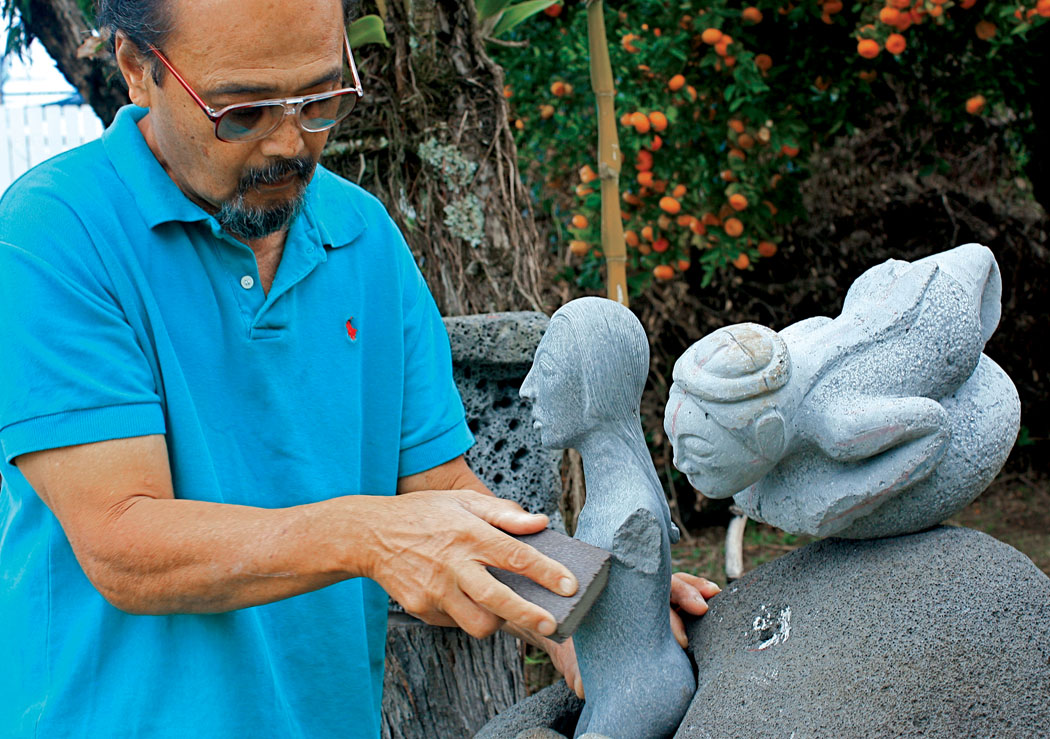
He has carved many Buddhas and Jizos, says Charlene. “Buddha, the ‘enlightened one’ is often sitting in the lotus position, has elongated ears [all-hearing] and a bump atop the head [all-knowing]. Jizo Bodhisattva or Jizo Bosatsu, is the Japanese guardian of women, children, and travelers. The Jizo is typically depicted with a shaved head, carrying a staff in the right hand and a wish-fulfilling jewel in the left hand.”
One Jizo is now installed at the Kamana Center tea garden, along with a stone lantern.
Figures inspired by Hawaiian lore include several kumu hula, one of which is installed at the University of Hawai‘i. A coral sculpture of the head of Queen Lili‘uokalani resides at Akiko‘s Bed and Breakfast in Wailea, north of Hilo. Akiko has been a patron of the sculptor, displaying a number of his pieces in her Buddhist gardens.
Describing the process of creating the queen’s image in coral, the artist says, “This is real wabi sabi. As I was carving, I came across a pebble that was imbedded in her chin. She actually had a mole there.”
“The compositions that I do are not from a picture, but all original, with no models. The theme of imperfection and incompletion runs through all of this.”
A complex, reclining figure of Na-maka-o-kaha‘i, a sea goddess, the older sister of Pele, was installed for a time in downtown Hilo in front of the Pacific Tsunami Museum. Unfortunately, vandals lopped off the head of the statue.
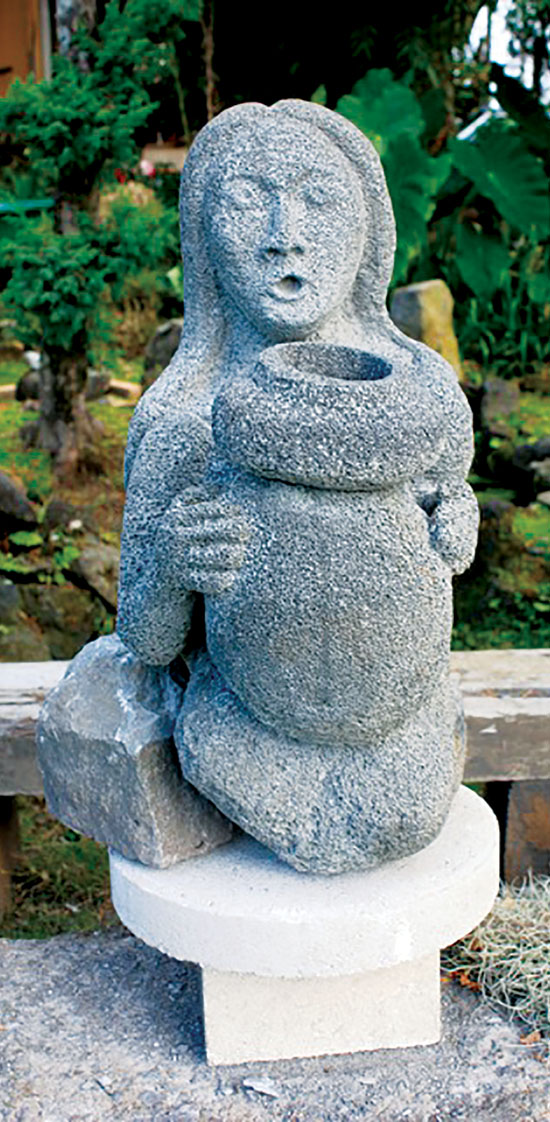
“The sculptures that I do have been prone to vandalism,” Fred says, quipping, “So much for my intimations of immortality.”
In 2019, he was honored for his contributions to UH-Hilo, Hawai‘i Community College, and the Hawai‘i Island community at large. The proclamation presented to Dr. Soriano reads in part:
WHEREAS, it is an honor to recognize Dr. Fred Soriano for his years of service to the University of Hawai‘i at Hilo and Hawai‘i Community College; and
Dr. Soriano has been an influential leader in the Filipino community; and
WHEREAS, Dr. Soriano has contributed greatly to local and university landscapes as a remarkable artist and sculptor honoring Hawai‘i’s people, culture, and history; and
WHEREAS, the University of Hawai‘i at Hilo and Hawai‘i Community College communities recognize the extraordinary service of Dr. Soriano in providing strong leadership in education, economics, agriculture, Hawaiian culture revitalization, sociology and social progress of Hawai‘i Island…
Today Fred shares his story in between three-times-a-week dialysis treatments for renal failure. He is in his fifth year of treatment and no longer able to work the stone.
He says, “In terms of imitations of immortality now it’s intimations of mortality. It’s wabi sabi again. Imperfection incompletion and impermanence.” ❖
For more information: chaleidesigns.com/artist/publications for Kālai Ki‘i Pōhaku, Carver of Stone by Charlene Asato
